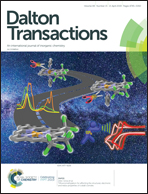Enantiomeric pairs of ternary copper(ii) complexes and their aldol-type condensation products: synthesis, characterization, and anticancer and epigenetic properties†
Abstract
Chiral enantiomers [Cu(phen)(L-ser)(H2O)]NO31 and [Cu(phen)(D-ser)(H2O)]NO32 (ser = serinato) underwent aldol-type condensation with formaldehyde, with retention of chirality, to yield their respective enantiomeric ternary copper(II) complexes, viz. L- and D-[Cu(phen)(OCA)(H2O)]NO3·xH2O (3 and 4; phen = 1,10-phenanthroline; OCA = oxazolidine-4-carboxylate; x = 1/2, 0–2) respectively. These chiral complexes were characterized by FTIR, elemental analysis, circular dichroism, UV-visible spectroscopy, fluorescence spectroscopy (FL), molar conductivity measurement, ESI-MS and X-ray crystallography. The crystal structures of 1 and 3 showed both the cationic complexes to have a square pyramidal geometry. These complexes were about nine fold more potent than cisplatin against metastatic MDA-MB-231 breast cancer cells, inducing apoptotic cell death via ROS generation and a massive drop in mitochondrial membrane potential. The results of monitoring EZH1, EZH2 and H3K27me3 revealed that the mode of action of 1–4 also involved the downregulation of EZH2 and it seemed to be independent of the H3K27me3 status.



 Please wait while we load your content...
Please wait while we load your content...